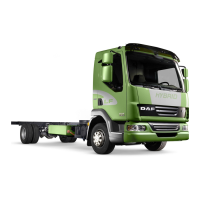©
200508 2-1
General
CLUTCH
ΛΦ45/55 series
3
9
2. GENERAL
2.1 SYSTEM DESCRIPTION, CLUTCH
The clutch is a single dry-plate clutch which is
hydraulically operated and pneumatically
assisted.
The clutch consists of:
- flywheel
- clutch plate
- clutch release assembly
By clamping the clutch plate between the
flywheel and the clutch release assembly, a
torque can be transferred (by means of friction).
The extent of the torque that can be transferred
by the clutch is determined by multiplying the
maximum engine torque by a safety factor
(usually 1.3).
To clamp the clutch plate, a diaphragm
(pressure) spring is used in the clutch release
assembly.
A diaphragm spring constitutes a simple, strong
and cost-effective construction.
Another advantage of the diaphragm spring is
that the pressure exerted on a new clutch plate
almost equals the pressure exerted on a worn
clutch plate.
A diaphragm spring requires a self-centring thrust
bearing.
The type of clutch plate used depends on the
following factors.
The size of the clutch plate lining must
correspond to the desired service life.
The character of the engine (the engine
vibrations to be damped) determines the version
of the vibration damper design in the hub.
For the clutch plate to engage smoothly the lining
material must abut the flywheel and clutch
release assembly evenly at all places when
engaging.
DAF LF Gearboxes and Clutch Service Manual

